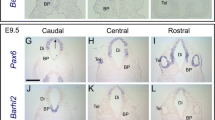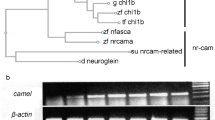Abstract
The Pax-1 gene has been found to play an important role in the development of the vertebral column. The cervico-occipital transitional zone is a specialized region of the vertebral column, and malformations of this region have frequently been described in humans. The exact embryonic border between head and trunk is a matter of controversy. In order to determine a possible role of Pax-1 in the development of the cervico-occipital transitional zone we studied the expression of this gene in a series of quail embryos and murine fetuses with in situ hybridization and immunohistochemistry. Pax-1 is expressed in all somites of the embryo, including the first five occipital ones. During embryonic days 3–5 the gene is down-regulated in the caudal direction within the first five somites, whereas more caudally Pax-1 is strongly expressed in the cells of the perinotochordal tube. In 5-day-old quail embryos, the cartilaginous anlage of the basioccipital bone has developed and there is no more expression of Pax-1 in this region. The fusion of the dens axis with the body of the axis also coincides with switching off of the Pax-1 gene. More caudally, the gene is continuously expressed in the intervertebral discs of murine embryos and therefore seems to be important for the process of resegmentation. Quail embryos do not possess permanent intervertebral discs. “Hyper-” or “hyposegmentation” defects may be explained by an over- or under-expression of Pax-1 during development. We also reinvestigated the border between the head and trunk in chick embryos by performing homotopical grafting experiments of the 5th somite between chick and quail embryos. Grafted quail cells formed mainly the caudal end of the basioccipital bone. They were also located in the cranial half of the ventral atlantic arch, and only a few cells were found in the tip of the dens axis.
Similar content being viewed by others
References
Albrecht P (1880) Über den Proatlas, einen zwischen dem Occipitale und dem Atlas der amnioten Wirbelthiere gelegenen Wirbel, und den Nervus spinalis I s. proatlanticus. Zool Anz 3:450–454; 472–478
Bagnall KM, Higgins SJ, Sanders EJ (1988) The contribution made by a single somite to the vertebral column: experimental evidence in support of resegmentation using the chick-quail chimera-model. Development 103:69–85
Balling R, Deutsch U, Gruss P (1988) Undulated, a mutation affecting the development of the mouse skeleton, has a point mutation in the paired box of Pax-1. Cell 55:531–535
Barge JAJ (1918) Probleme im Kranio-Vertebralgebiet. Verh K Akad Wet Amsterdam (Tweede Sectie). Deel. XX, no 2. Müller, Amsterdam
Blechschmidt E (1961) The stages of human development before birth. Karger, Basel London New York, pp 1–684
Brand-Saberi B, Ebensperger C, Wilting J, Balling R, Christ B (1993) The ventralizing effect of the notochord on somite differentiation in chick embyros. Anat Embryol 188:239–245
Bystrow OP (1931) Assimilation des Atlas und Manifestation des Proatlas. Z Anat Entwicklungsgesch 95:210–242
Chalepakis G, Fritsch R, Fickenscher H, Deutsch U, Goulding M, Gruss P (1991) The molecular basis of the undulated/Pax-1 mutation. Cell 66:873–884
Charité J, Graaff W de, Shen S, Dechamps J (1994) Ectopic expression of Hoxb-8 causes duplication of the ZPA in the forelimb and homeotic transformation of axial structures. Cell 78:589–601
Christ B, Ordahl CP (1995) Early stages of chick somite development. Anat Embryol 191:381–396
Christ B, Wilting J (1992) From somites to vertebral column. Ann Anat 174:23–32
Christ B, Jacob HJ, Jacob M (1979) Über Gestaltungsfunktionen der Somiten bei der Entwicklung der Körperwand von Hühnerembryonen. Verh Anat Ges 73:509–518
Condie BG, Capecchi MR (1994) Mice with targeted disruptions in the paralogous genes hoxa-3 and hoxd-3 reveal synergistic interactions. Nature 370:304–307
Couly GF, Coltey PM, Le Douarin NM (1993) The triple origin of the skull in higher vertebrates: a study in quail-chick chimeras. Development 117:409–429
Deutsch U, Dressler GR, Gruss P (1988) Pax 1, a member of a paired box homologous murine gene family, is expressed in segmented structures during development. Cell 53:617–625
Dietrich S, Schubert FR, Gruss P (1993) Altered Pax gene expression in murine notochord mutants: the notochord is required to initiate and maintain ventral identity in the somite. Mech Dev 44:189–207
Ebensperger C, Wilting J, Brand-Saberi B, Mizutani Y, Christ B, Balling R, Koseki H (1995) Pax-1, a regulator of sclerotome development is induced by notochord and floor plate signals in avian embryos. Anat Embryol 191:297–310
Ebner E von (1888) Urwirbel und Neugliederung der Wirbelsäule. Sitzungsber Akad Wiss Wien III/97:194–206
Froriep A (1883) Zur Entwicklungsgeschichte der Wirbelsäule, insbesondere des Atlas und Epistropheus und der Occipitalregion. Arch Anat Physiol Anat Abt 177–234
Glaesmer E (1909) Die Atlanto-Occipital-Synostose. Über ihre pathologischen und morphologischen Ursachen auf Grund eines Weichteilpräparates. Anat Anz 36:129–148.
Hadley LA (1948) Atlanto-occipital fusion, ossiculum terminale, occipitale vertebra as related to basilar impression with neurological symptoms. Am J Roentgenol 59:511–524
Hayek H von (1923) Über den Proatlas und über die Entwicklung der Kopfgelenke beim Menschen und bei einigen Säugetieren. Sitzungsber Akad Wiss Wien, Math Naturwiss Kl Abt 3 130/131:25–60
Hayek H von (1924) Über das Schicksal des Proatlas und über die Entwicklung der Kopfgelenke bei Reptilien und Vögeln. Morphol Jahrb 53:137–163
Huang R, Zhi Q, Wilting J, Christ B (1994) The fate of somitocoele cells in avian embryos. Anat Embryol 190:243–250
Hunter RH (1923) An abnormal atlas. J Anat 58:140–141
Jacob M, Christ B, Jacob HJ (1975) Über die regionale Determination des paraxialen Mesoderms junger Hühnerembryonen. Verh Anat Ges 69:263–269
Jenkins FA (1969) The evolution and development of the dens of the mammalian axis. Anat Rec 164:173–184
Kessel M, Gruss P (1991) Homeotic transformations of murine vertebrae and concomitant alteration of Hox codes induced by retinoic acid. Cell 67:1–20
Kessel M, Balling R, Gruss P (1990) Variations of cervical vertebrae after expression of a Hox-1.1 transgene in mice. Cell 61:301–308
Kieny M, Mauger A, Sengel P (1972) Early regionalization of the somitic mesoderm as studied by the development of the axial skeleton of the chick embryo. Dev Biol 28:142–161
Kladetzky J (1954) Zur Entwicklung des Dens epistrophei. Morphol Jahrb 94:520–550
Koseki H, Wallin J, Wilting J, Mizutani Y, Kispert A, Ebensperger C, Herrmann BG, Christ B, Balling R (1993) A role for Pax-1 as a mediator of notochordal signals during the dorsoventral specification of vertebrae. Development 119:649–660
Le Douarin NM (1969) Particularités du noyau interphasique chez la caille japonaise (Coturnix coturnix japonica). Utilisation de ces particularités comme “marquage biologique” dans les recherches sur les interactions tissulaires et les migrationes cellulaires au cours de l'ontogenèse. Bull Biol Fr Belg 103:435–452
Lewis EB (1978) A gene complex controlling segmentation in Drosophila. Nature 276:565–570
Müller F, O'Rahilly R (1994) Occipitocervical segmentation in staged human embryos. J Anat 185:251–258
Putz R (1975) Zur Manifestation der hypochordalen Spangen im cranio-vertebralen Grenzgebiet beim Menschen. Anat Anz 137:65–74
Reiter A (1944) Die Frühentwicklung der menschlichen Wirbelsäule. II. Mitteilung: Die Entwicklung der Occipitalsegmente und der Halswirbelsäule. Z Anat Entwicklungsgesch 113:66–104
Remak R (1855) Untersuchungen über die Entwicklung der Wirbeltiere. Reimer, Berlin
Rentrop M, Knapp B, Winter H, Schweizer J (1986) Differential localization of distinct keratin RNA-species in mouse tongue epithelium by in situ hybridization with specific cDNA probes. J Cell Biol 103:2583–2591
Rosen B, Beddington RSP (1993) Whole-mount in situ hybridization in the mouse embryo: gene expression in three dimensions. Trends Genet 9:162–167
Sensenig EC (1957) The development of the occipital and cervical segments and their associated structures in human embryos. Contrib Embryol Carnegie Inst 36:141–151
Serra JA (1946) Histochemical tests for protein and aminoacids: the characterization of basic proteins. Stain Technol 21:5–18
Timmons PM, Wallin J, Rigby PWJ, Balling R (1994) Expression and function of Pax-1 during development of the pectoral girdle. Development 120:2773–2785
Verbout AJ (1985) The development of the vertebral column. Adv Anat Embryol Cell Biol 90:1–122
Wallin J, Wilting J, Koseki H, Fritsch R, Christ B, Balling R (1994) The role of Pax-1 in axial skeleton development. Development 120:1109–1121
Wilting J, Kurz H, Brand-Saberi B, Steding G, Yang YX, Hasselhorn HM, Epperlein HH, Christ B (1994) Kinetics and differentiation of somitic cells forming the vertebral column: studies on human and chick embryos. Anat Embryol 190:573–581
Author information
Authors and Affiliations
Rights and permissions
About this article
Cite this article
Wilting, J., Ebensperger, C., Müller, T.S. et al. Pax-1 in the development of the cervico-occipital transitional zone. Anat Embryol 192, 221–227 (1995). https://doi.org/10.1007/BF00184746
Accepted:
Issue Date:
DOI: https://doi.org/10.1007/BF00184746




